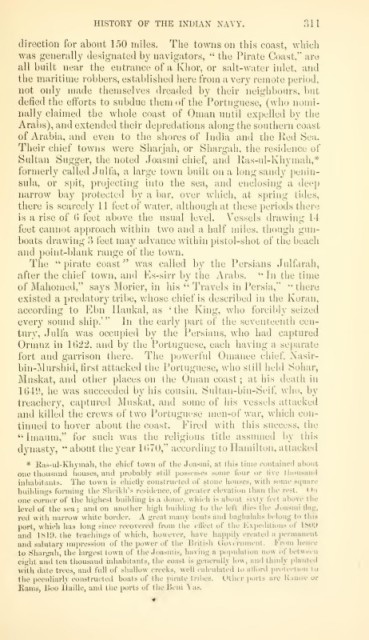Page 343 - INDIANNAVYV1
P. 343
HISTORY OF THE INDIAN NAVY. 311
direction for about 150 miles. The towns on this coast, which
was generally designated by navigators, " the Pirate Coast," are
all built near the entrance of a Khor, or salt-water inlet, and
the maritime robbers, established here from a very remote period,
not only made themselves dreaded by their neighbours, but
defied the efforts to subdue them of the Portuguese, (who nomi-
nally claimed the whole coast of Oman until expelled by the
Arabs), and extended their depredations along tiie southern coast
of Arabia, and even to the shores of India and ihe Ked Sea.
Their chief towns were Sharjah, or Shargah, the residence of
Sultan Sugger, the noted Joasmi chief, and Ras-ul-Khymah,*
formerly called Julfa, a large town built on a long sandy penin-
sula, or spit, projecting into the sea, and enclosing a deep
narrow bay protected by a bar, over which, at spring tides,
there is scarcely 11 feet of water, although at these periods there
is a rise of 6 feet above the usual level. Vessels drawing 1-1
feet cannot approach within two and a half miles, though gun-
boats drawing 3 feet may advance within pistol-shot of the beach
and point-blank range of the town.
The "pirate coast" was called by the Persians Julfarah,
after the chief town, and P]s-sirr by the Arabs. "In the time
of Mahomed," says ]\lorier, in his "Travels in Persia," "there
existed a predatory tribe, whose chief is described in the Koran,
according to Ebn Haukal, as 'the King, who forcibly seized
every sound ship.'" In the early part of the seventeenth cen-
tury, Julfa was occupied by the Persians, who had captured
Ormuz in 1G22, and by the Portuguese, each having a separate
fort and garrison there. The powerful Omanee chief. Nasir-
bin-Murshid, first attacked the Portuguese, who still huld Sohar,
]\Iuskat, and other places on the Oman coast; at his death in
1649, he was succeeded by his cousin, Sultan-bin-Seif, who, by
treachery, captured Muskat, and some of his vessels attacked
and killed the crews of two Portuguese men-of war, which con-
tinued to hover about the coast. Fired with this success, the
" Imaum," for such was the religious title assumed by this
dynasty, " about the year 1()70," according to Hamilton, attacked
* Eas-ul-Khyinali, tlic cliiof town of the Joasmi, at this time oontainod ab(»ut
one thou.siuid houses, and jjrobably still possesses some lour or live thousand
inhabitants. The town is chielly construeled ol' stone houses, with some square
On
buildings forming the Sheikh's resilience, of greater elevation than the rest.
one corner of the highest building is a dome, which is about sixty feet above the
level of the sea; and on another high building to the left Hies the Joasmi lliig,
red with narrow white border. A great many boats and baghalahs belong to this
port, which has long since recovered from the elleet of the Ivxiiedilions of ISO!)
and ISIO, the teachings of which, however, have hap])ih- created a permanent
and salutary nnpression of the jjower of the lirilisli Ciovtrnment. From hence
to Shargah, the largest town of tlie Juasmis, having a population now of between
eight and ten thousand inhabitants, tlie coast is generally low, ami thinly planted
with date trees, and full of shallow creeks, well calculated to allord protection to
the peculiarly constructed boats of the ]iirate tribes. Other ports arc Kauise or
Earns, lioo liaille, ajid the ports of thcEcni ias.

